Promoting Positive Behaviour: A Comprehensive Report for Care UK
VerifiedAdded on 2020/07/23
|7
|1621
|483
Report
AI Summary
This report, prepared for Care UK, examines strategies for promoting positive behaviour in health and social care settings. It covers various interventions, including functional behaviour assessments and proactive strategies, and discusses the importance of child-centered approaches. The report also addresses restrictive interventions, emphasizing the need for least restrictive approaches and preventive measures. It differentiates between proactive and reactive strategies, highlights best practices for promoting positive behaviour, and outlines steps to maintain respect, dignity, and well-being of individuals. The report concludes with a summary of key findings and references relevant literature, providing a comprehensive overview of managing challenging behaviours and fostering a positive environment within health and social care.
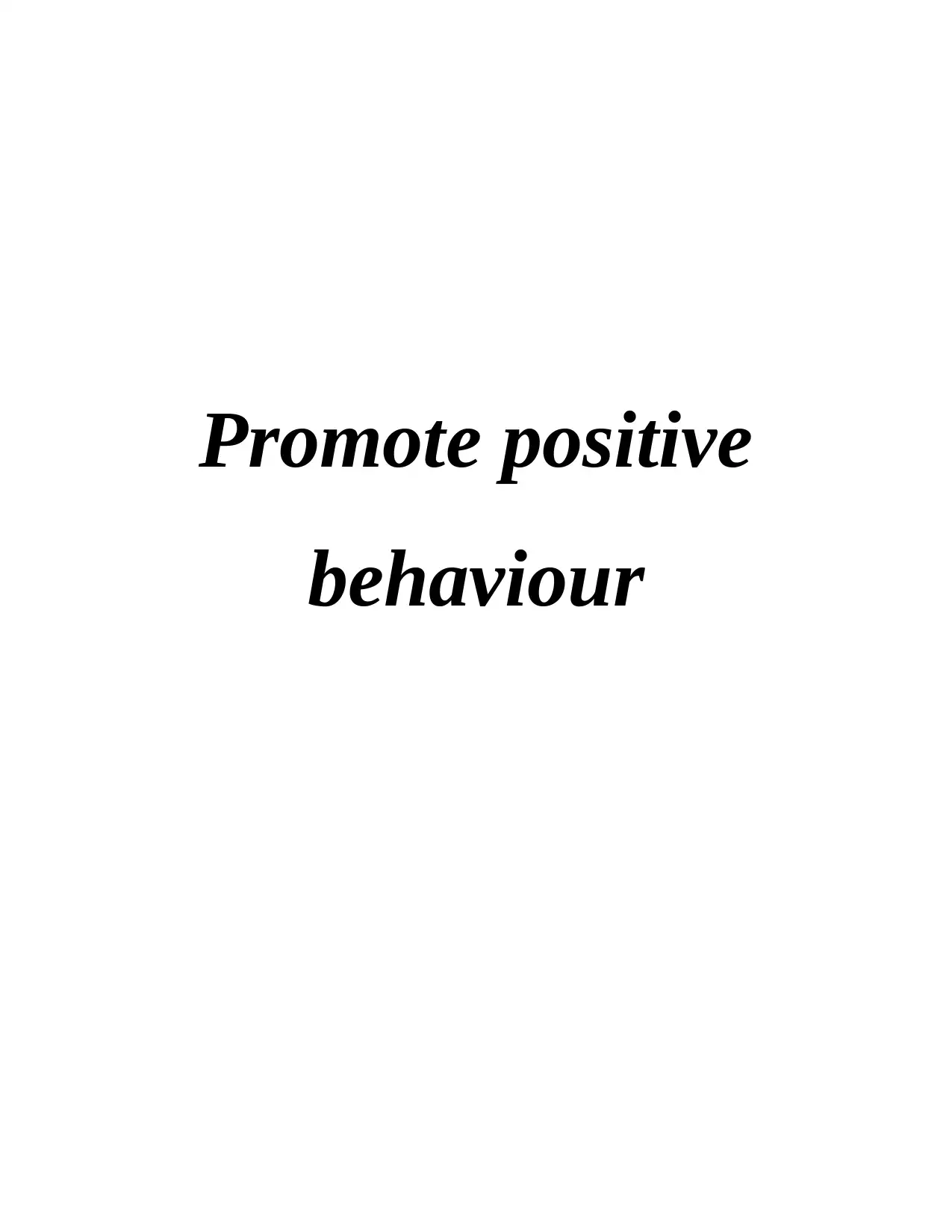
Promote positive
behaviour
behaviour
Paraphrase This Document
Need a fresh take? Get an instant paraphrase of this document with our AI Paraphraser
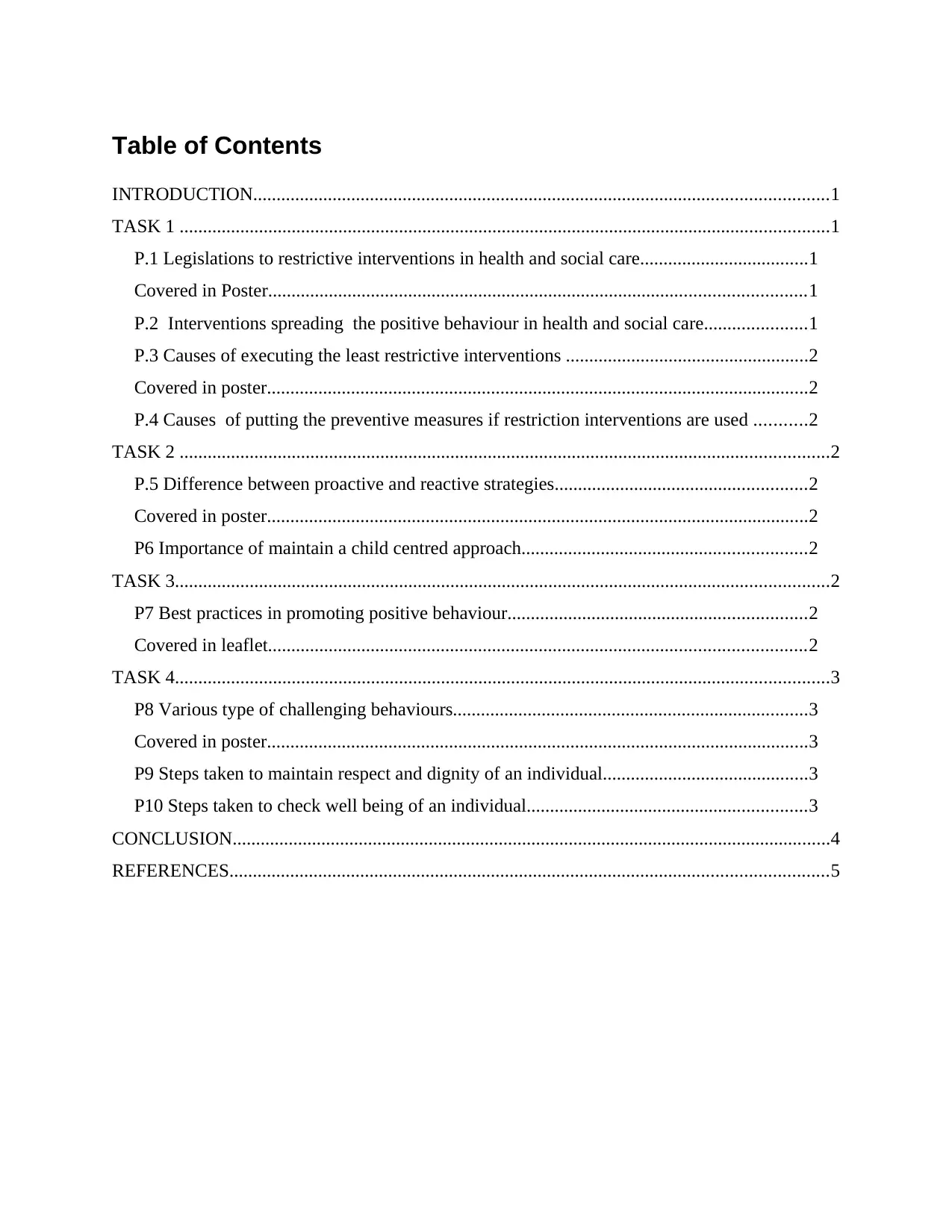
Table of Contents
INTRODUCTION...........................................................................................................................1
TASK 1 ...........................................................................................................................................1
P.1 Legislations to restrictive interventions in health and social care....................................1
Covered in Poster...................................................................................................................1
P.2 Interventions spreading the positive behaviour in health and social care......................1
P.3 Causes of executing the least restrictive interventions ....................................................2
Covered in poster....................................................................................................................2
P.4 Causes of putting the preventive measures if restriction interventions are used ...........2
TASK 2 ...........................................................................................................................................2
P.5 Difference between proactive and reactive strategies......................................................2
Covered in poster....................................................................................................................2
P6 Importance of maintain a child centred approach.............................................................2
TASK 3............................................................................................................................................2
P7 Best practices in promoting positive behaviour................................................................2
Covered in leaflet...................................................................................................................2
TASK 4............................................................................................................................................3
P8 Various type of challenging behaviours............................................................................3
Covered in poster....................................................................................................................3
P9 Steps taken to maintain respect and dignity of an individual............................................3
P10 Steps taken to check well being of an individual............................................................3
CONCLUSION................................................................................................................................4
REFERENCES................................................................................................................................5
INTRODUCTION...........................................................................................................................1
TASK 1 ...........................................................................................................................................1
P.1 Legislations to restrictive interventions in health and social care....................................1
Covered in Poster...................................................................................................................1
P.2 Interventions spreading the positive behaviour in health and social care......................1
P.3 Causes of executing the least restrictive interventions ....................................................2
Covered in poster....................................................................................................................2
P.4 Causes of putting the preventive measures if restriction interventions are used ...........2
TASK 2 ...........................................................................................................................................2
P.5 Difference between proactive and reactive strategies......................................................2
Covered in poster....................................................................................................................2
P6 Importance of maintain a child centred approach.............................................................2
TASK 3............................................................................................................................................2
P7 Best practices in promoting positive behaviour................................................................2
Covered in leaflet...................................................................................................................2
TASK 4............................................................................................................................................3
P8 Various type of challenging behaviours............................................................................3
Covered in poster....................................................................................................................3
P9 Steps taken to maintain respect and dignity of an individual............................................3
P10 Steps taken to check well being of an individual............................................................3
CONCLUSION................................................................................................................................4
REFERENCES................................................................................................................................5
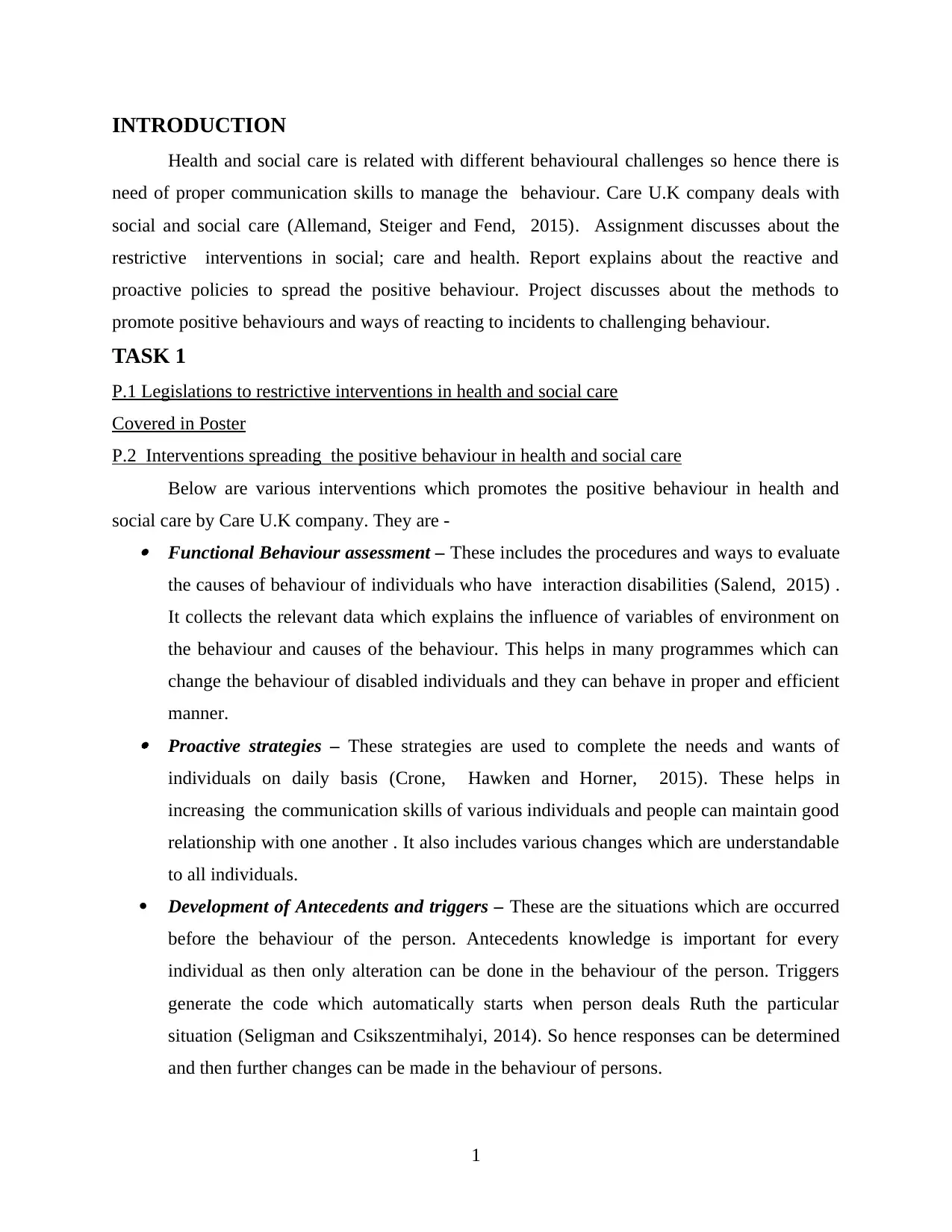
INTRODUCTION
Health and social care is related with different behavioural challenges so hence there is
need of proper communication skills to manage the behaviour. Care U.K company deals with
social and social care (Allemand, Steiger and Fend, 2015). Assignment discusses about the
restrictive interventions in social; care and health. Report explains about the reactive and
proactive policies to spread the positive behaviour. Project discusses about the methods to
promote positive behaviours and ways of reacting to incidents to challenging behaviour.
TASK 1
P.1 Legislations to restrictive interventions in health and social care
Covered in Poster
P.2 Interventions spreading the positive behaviour in health and social care
Below are various interventions which promotes the positive behaviour in health and
social care by Care U.K company. They are - Functional Behaviour assessment – These includes the procedures and ways to evaluate
the causes of behaviour of individuals who have interaction disabilities (Salend, 2015) .
It collects the relevant data which explains the influence of variables of environment on
the behaviour and causes of the behaviour. This helps in many programmes which can
change the behaviour of disabled individuals and they can behave in proper and efficient
manner. Proactive strategies – These strategies are used to complete the needs and wants of
individuals on daily basis (Crone, Hawken and Horner, 2015). These helps in
increasing the communication skills of various individuals and people can maintain good
relationship with one another . It also includes various changes which are understandable
to all individuals.
Development of Antecedents and triggers – These are the situations which are occurred
before the behaviour of the person. Antecedents knowledge is important for every
individual as then only alteration can be done in the behaviour of the person. Triggers
generate the code which automatically starts when person deals Ruth the particular
situation (Seligman and Csikszentmihalyi, 2014). So hence responses can be determined
and then further changes can be made in the behaviour of persons.
1
Health and social care is related with different behavioural challenges so hence there is
need of proper communication skills to manage the behaviour. Care U.K company deals with
social and social care (Allemand, Steiger and Fend, 2015). Assignment discusses about the
restrictive interventions in social; care and health. Report explains about the reactive and
proactive policies to spread the positive behaviour. Project discusses about the methods to
promote positive behaviours and ways of reacting to incidents to challenging behaviour.
TASK 1
P.1 Legislations to restrictive interventions in health and social care
Covered in Poster
P.2 Interventions spreading the positive behaviour in health and social care
Below are various interventions which promotes the positive behaviour in health and
social care by Care U.K company. They are - Functional Behaviour assessment – These includes the procedures and ways to evaluate
the causes of behaviour of individuals who have interaction disabilities (Salend, 2015) .
It collects the relevant data which explains the influence of variables of environment on
the behaviour and causes of the behaviour. This helps in many programmes which can
change the behaviour of disabled individuals and they can behave in proper and efficient
manner. Proactive strategies – These strategies are used to complete the needs and wants of
individuals on daily basis (Crone, Hawken and Horner, 2015). These helps in
increasing the communication skills of various individuals and people can maintain good
relationship with one another . It also includes various changes which are understandable
to all individuals.
Development of Antecedents and triggers – These are the situations which are occurred
before the behaviour of the person. Antecedents knowledge is important for every
individual as then only alteration can be done in the behaviour of the person. Triggers
generate the code which automatically starts when person deals Ruth the particular
situation (Seligman and Csikszentmihalyi, 2014). So hence responses can be determined
and then further changes can be made in the behaviour of persons.
1
⊘ This is a preview!⊘
Do you want full access?
Subscribe today to unlock all pages.

Trusted by 1+ million students worldwide
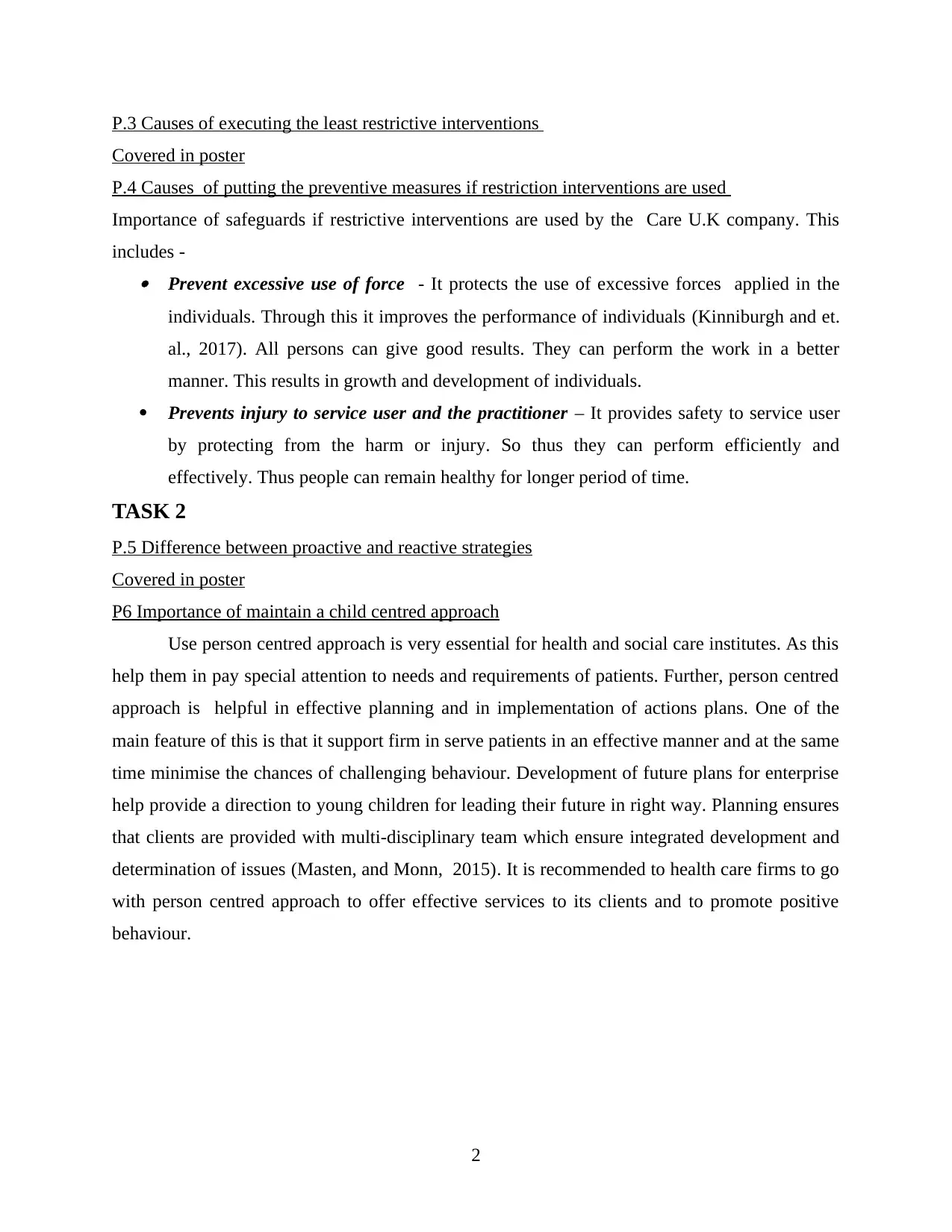
P.3 Causes of executing the least restrictive interventions
Covered in poster
P.4 Causes of putting the preventive measures if restriction interventions are used
Importance of safeguards if restrictive interventions are used by the Care U.K company. This
includes - Prevent excessive use of force - It protects the use of excessive forces applied in the
individuals. Through this it improves the performance of individuals (Kinniburgh and et.
al., 2017). All persons can give good results. They can perform the work in a better
manner. This results in growth and development of individuals.
Prevents injury to service user and the practitioner – It provides safety to service user
by protecting from the harm or injury. So thus they can perform efficiently and
effectively. Thus people can remain healthy for longer period of time.
TASK 2
P.5 Difference between proactive and reactive strategies
Covered in poster
P6 Importance of maintain a child centred approach
Use person centred approach is very essential for health and social care institutes. As this
help them in pay special attention to needs and requirements of patients. Further, person centred
approach is helpful in effective planning and in implementation of actions plans. One of the
main feature of this is that it support firm in serve patients in an effective manner and at the same
time minimise the chances of challenging behaviour. Development of future plans for enterprise
help provide a direction to young children for leading their future in right way. Planning ensures
that clients are provided with multi-disciplinary team which ensure integrated development and
determination of issues (Masten, and Monn, 2015). It is recommended to health care firms to go
with person centred approach to offer effective services to its clients and to promote positive
behaviour.
2
Covered in poster
P.4 Causes of putting the preventive measures if restriction interventions are used
Importance of safeguards if restrictive interventions are used by the Care U.K company. This
includes - Prevent excessive use of force - It protects the use of excessive forces applied in the
individuals. Through this it improves the performance of individuals (Kinniburgh and et.
al., 2017). All persons can give good results. They can perform the work in a better
manner. This results in growth and development of individuals.
Prevents injury to service user and the practitioner – It provides safety to service user
by protecting from the harm or injury. So thus they can perform efficiently and
effectively. Thus people can remain healthy for longer period of time.
TASK 2
P.5 Difference between proactive and reactive strategies
Covered in poster
P6 Importance of maintain a child centred approach
Use person centred approach is very essential for health and social care institutes. As this
help them in pay special attention to needs and requirements of patients. Further, person centred
approach is helpful in effective planning and in implementation of actions plans. One of the
main feature of this is that it support firm in serve patients in an effective manner and at the same
time minimise the chances of challenging behaviour. Development of future plans for enterprise
help provide a direction to young children for leading their future in right way. Planning ensures
that clients are provided with multi-disciplinary team which ensure integrated development and
determination of issues (Masten, and Monn, 2015). It is recommended to health care firms to go
with person centred approach to offer effective services to its clients and to promote positive
behaviour.
2
Paraphrase This Document
Need a fresh take? Get an instant paraphrase of this document with our AI Paraphraser
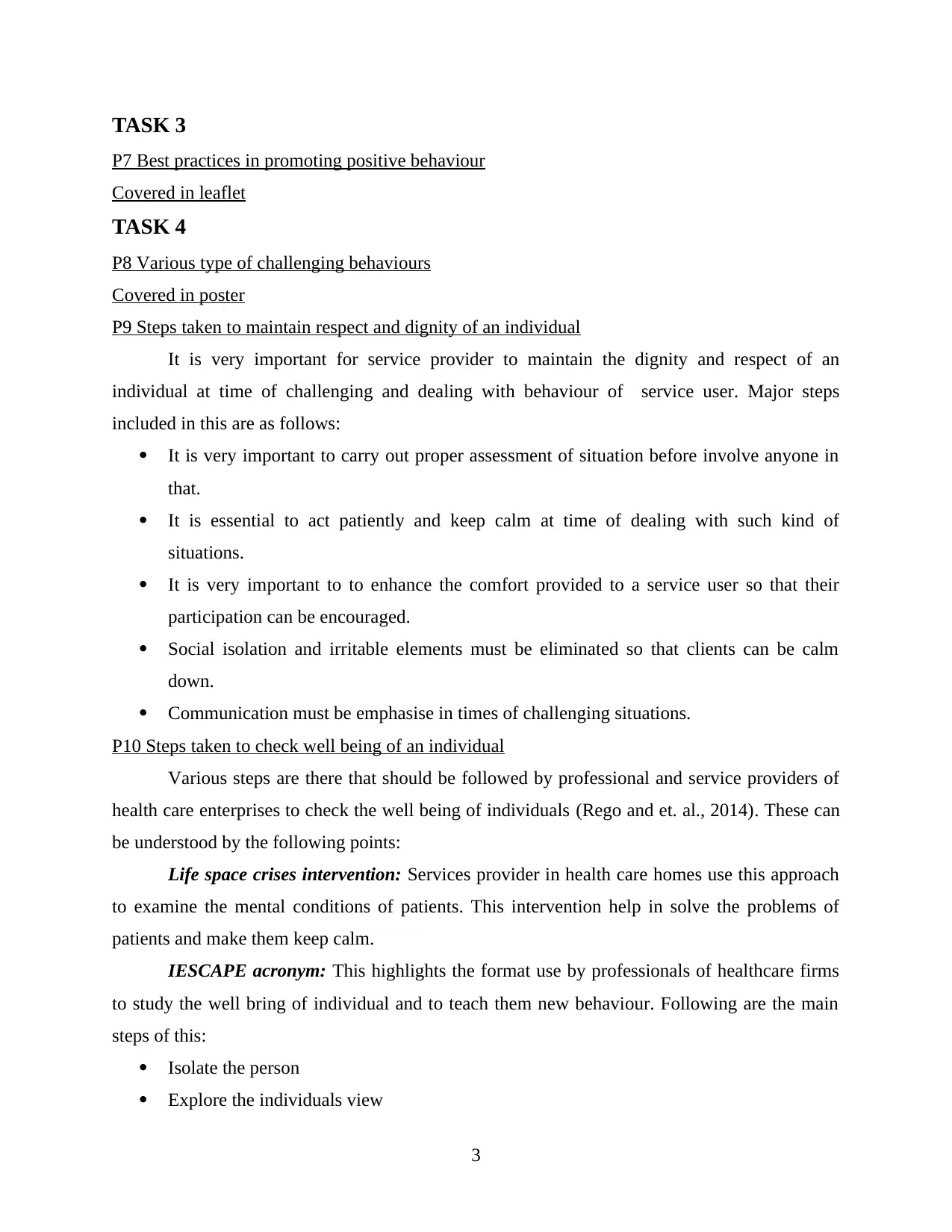
TASK 3
P7 Best practices in promoting positive behaviour
Covered in leaflet
TASK 4
P8 Various type of challenging behaviours
Covered in poster
P9 Steps taken to maintain respect and dignity of an individual
It is very important for service provider to maintain the dignity and respect of an
individual at time of challenging and dealing with behaviour of service user. Major steps
included in this are as follows:
It is very important to carry out proper assessment of situation before involve anyone in
that.
It is essential to act patiently and keep calm at time of dealing with such kind of
situations.
It is very important to to enhance the comfort provided to a service user so that their
participation can be encouraged.
Social isolation and irritable elements must be eliminated so that clients can be calm
down.
Communication must be emphasise in times of challenging situations.
P10 Steps taken to check well being of an individual
Various steps are there that should be followed by professional and service providers of
health care enterprises to check the well being of individuals (Rego and et. al., 2014). These can
be understood by the following points:
Life space crises intervention: Services provider in health care homes use this approach
to examine the mental conditions of patients. This intervention help in solve the problems of
patients and make them keep calm.
IESCAPE acronym: This highlights the format use by professionals of healthcare firms
to study the well bring of individual and to teach them new behaviour. Following are the main
steps of this:
Isolate the person
Explore the individuals view
3
P7 Best practices in promoting positive behaviour
Covered in leaflet
TASK 4
P8 Various type of challenging behaviours
Covered in poster
P9 Steps taken to maintain respect and dignity of an individual
It is very important for service provider to maintain the dignity and respect of an
individual at time of challenging and dealing with behaviour of service user. Major steps
included in this are as follows:
It is very important to carry out proper assessment of situation before involve anyone in
that.
It is essential to act patiently and keep calm at time of dealing with such kind of
situations.
It is very important to to enhance the comfort provided to a service user so that their
participation can be encouraged.
Social isolation and irritable elements must be eliminated so that clients can be calm
down.
Communication must be emphasise in times of challenging situations.
P10 Steps taken to check well being of an individual
Various steps are there that should be followed by professional and service providers of
health care enterprises to check the well being of individuals (Rego and et. al., 2014). These can
be understood by the following points:
Life space crises intervention: Services provider in health care homes use this approach
to examine the mental conditions of patients. This intervention help in solve the problems of
patients and make them keep calm.
IESCAPE acronym: This highlights the format use by professionals of healthcare firms
to study the well bring of individual and to teach them new behaviour. Following are the main
steps of this:
Isolate the person
Explore the individuals view
3
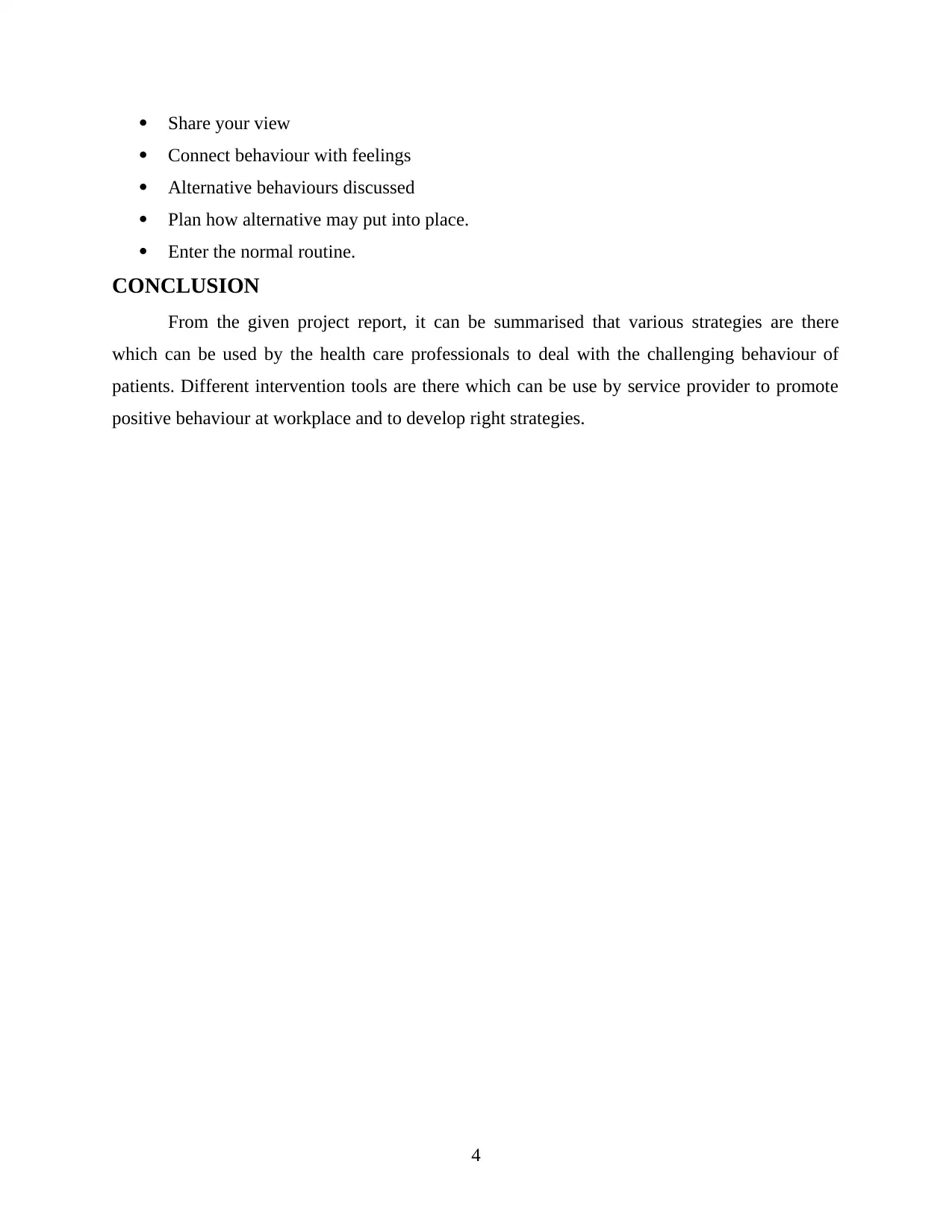
Share your view
Connect behaviour with feelings
Alternative behaviours discussed
Plan how alternative may put into place.
Enter the normal routine.
CONCLUSION
From the given project report, it can be summarised that various strategies are there
which can be used by the health care professionals to deal with the challenging behaviour of
patients. Different intervention tools are there which can be use by service provider to promote
positive behaviour at workplace and to develop right strategies.
4
Connect behaviour with feelings
Alternative behaviours discussed
Plan how alternative may put into place.
Enter the normal routine.
CONCLUSION
From the given project report, it can be summarised that various strategies are there
which can be used by the health care professionals to deal with the challenging behaviour of
patients. Different intervention tools are there which can be use by service provider to promote
positive behaviour at workplace and to develop right strategies.
4
⊘ This is a preview!⊘
Do you want full access?
Subscribe today to unlock all pages.

Trusted by 1+ million students worldwide
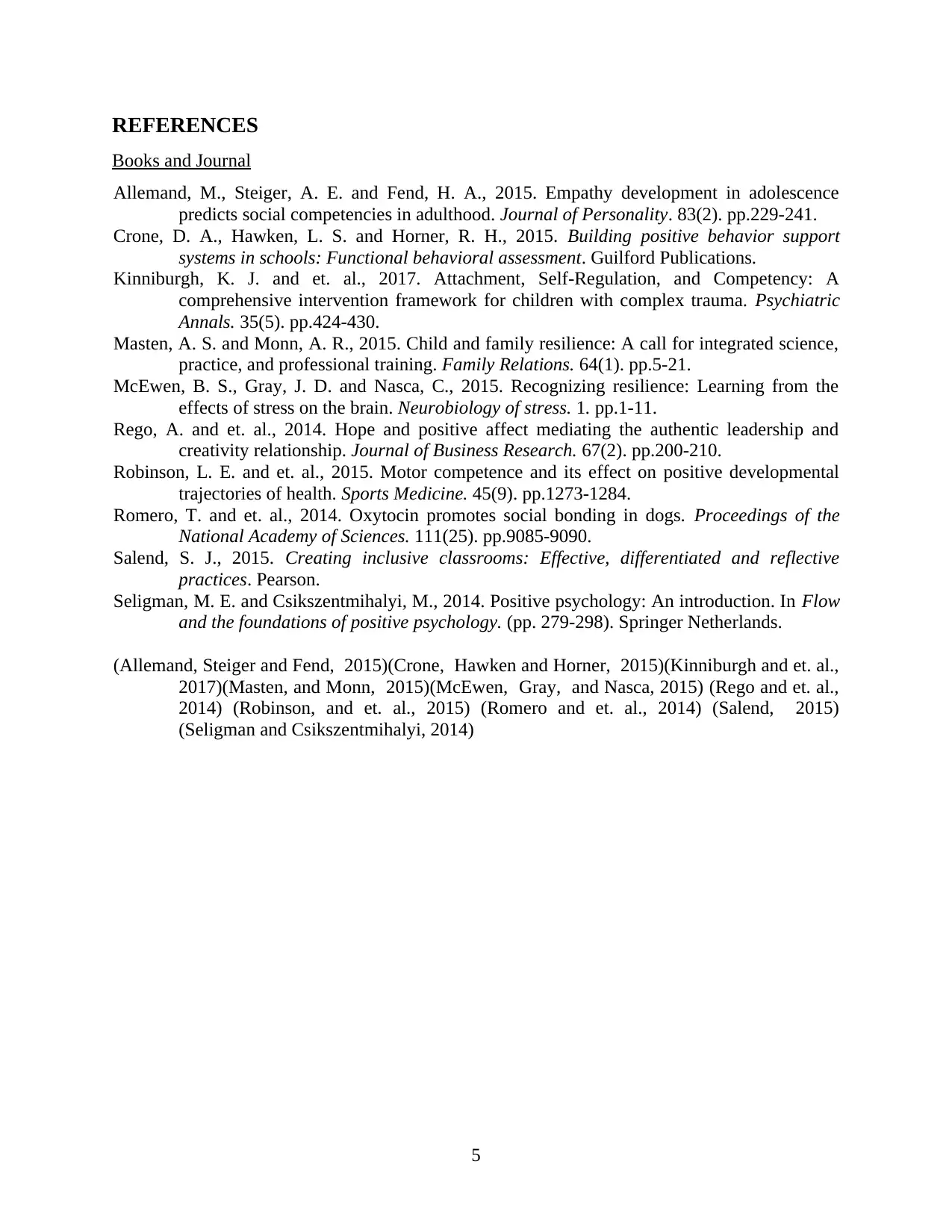
REFERENCES
Books and Journal
Allemand, M., Steiger, A. E. and Fend, H. A., 2015. Empathy development in adolescence
predicts social competencies in adulthood. Journal of Personality. 83(2). pp.229-241.
Crone, D. A., Hawken, L. S. and Horner, R. H., 2015. Building positive behavior support
systems in schools: Functional behavioral assessment. Guilford Publications.
Kinniburgh, K. J. and et. al., 2017. Attachment, Self-Regulation, and Competency: A
comprehensive intervention framework for children with complex trauma. Psychiatric
Annals. 35(5). pp.424-430.
Masten, A. S. and Monn, A. R., 2015. Child and family resilience: A call for integrated science,
practice, and professional training. Family Relations. 64(1). pp.5-21.
McEwen, B. S., Gray, J. D. and Nasca, C., 2015. Recognizing resilience: Learning from the
effects of stress on the brain. Neurobiology of stress. 1. pp.1-11.
Rego, A. and et. al., 2014. Hope and positive affect mediating the authentic leadership and
creativity relationship. Journal of Business Research. 67(2). pp.200-210.
Robinson, L. E. and et. al., 2015. Motor competence and its effect on positive developmental
trajectories of health. Sports Medicine. 45(9). pp.1273-1284.
Romero, T. and et. al., 2014. Oxytocin promotes social bonding in dogs. Proceedings of the
National Academy of Sciences. 111(25). pp.9085-9090.
Salend, S. J., 2015. Creating inclusive classrooms: Effective, differentiated and reflective
practices. Pearson.
Seligman, M. E. and Csikszentmihalyi, M., 2014. Positive psychology: An introduction. In Flow
and the foundations of positive psychology. (pp. 279-298). Springer Netherlands.
(Allemand, Steiger and Fend, 2015)(Crone, Hawken and Horner, 2015)(Kinniburgh and et. al.,
2017)(Masten, and Monn, 2015)(McEwen, Gray, and Nasca, 2015) (Rego and et. al.,
2014) (Robinson, and et. al., 2015) (Romero and et. al., 2014) (Salend, 2015)
(Seligman and Csikszentmihalyi, 2014)
5
Books and Journal
Allemand, M., Steiger, A. E. and Fend, H. A., 2015. Empathy development in adolescence
predicts social competencies in adulthood. Journal of Personality. 83(2). pp.229-241.
Crone, D. A., Hawken, L. S. and Horner, R. H., 2015. Building positive behavior support
systems in schools: Functional behavioral assessment. Guilford Publications.
Kinniburgh, K. J. and et. al., 2017. Attachment, Self-Regulation, and Competency: A
comprehensive intervention framework for children with complex trauma. Psychiatric
Annals. 35(5). pp.424-430.
Masten, A. S. and Monn, A. R., 2015. Child and family resilience: A call for integrated science,
practice, and professional training. Family Relations. 64(1). pp.5-21.
McEwen, B. S., Gray, J. D. and Nasca, C., 2015. Recognizing resilience: Learning from the
effects of stress on the brain. Neurobiology of stress. 1. pp.1-11.
Rego, A. and et. al., 2014. Hope and positive affect mediating the authentic leadership and
creativity relationship. Journal of Business Research. 67(2). pp.200-210.
Robinson, L. E. and et. al., 2015. Motor competence and its effect on positive developmental
trajectories of health. Sports Medicine. 45(9). pp.1273-1284.
Romero, T. and et. al., 2014. Oxytocin promotes social bonding in dogs. Proceedings of the
National Academy of Sciences. 111(25). pp.9085-9090.
Salend, S. J., 2015. Creating inclusive classrooms: Effective, differentiated and reflective
practices. Pearson.
Seligman, M. E. and Csikszentmihalyi, M., 2014. Positive psychology: An introduction. In Flow
and the foundations of positive psychology. (pp. 279-298). Springer Netherlands.
(Allemand, Steiger and Fend, 2015)(Crone, Hawken and Horner, 2015)(Kinniburgh and et. al.,
2017)(Masten, and Monn, 2015)(McEwen, Gray, and Nasca, 2015) (Rego and et. al.,
2014) (Robinson, and et. al., 2015) (Romero and et. al., 2014) (Salend, 2015)
(Seligman and Csikszentmihalyi, 2014)
5
1 out of 7
Related Documents
Your All-in-One AI-Powered Toolkit for Academic Success.
+13062052269
info@desklib.com
Available 24*7 on WhatsApp / Email
![[object Object]](/_next/static/media/star-bottom.7253800d.svg)
Unlock your academic potential
Copyright © 2020–2025 A2Z Services. All Rights Reserved. Developed and managed by ZUCOL.





